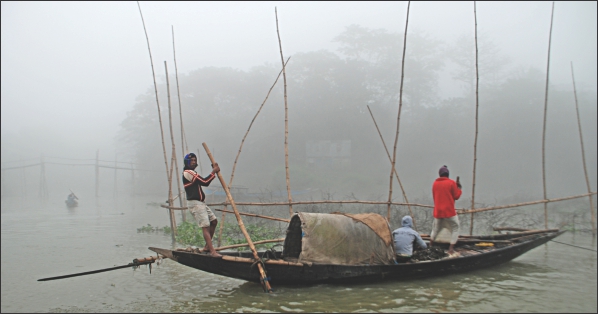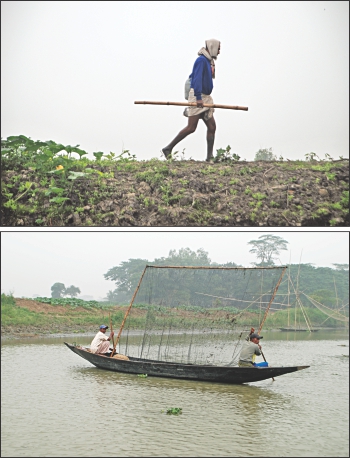Farmers’s Voice
Landscapes of Prospect and Fright
Few days back I went to the Arial Beel (Wetland) as part of the Firey Chol Matir Taney (Returning to Roots) 'Season 3' mission, the youth leadership programme Hridoye Mati O Manush is doing for last three years. I have been there many times and the natural resources at the Arial Beel always impressed me and I always firmly believed this region should be conserved with more attention. The day out at the Arial Beel with the university students who participated at this year's Returning to Roots, was simply amazing.
.................................................................................................
Shykh Seraj

We are now heading towards Bangladesh's unique-most natural resources region, Arial Beel (Wetland).
We started from Alamghaat (Munshiganj) and headed towards the Arial Beel (Wetland) over a branch river of Isamoti. The branch river finally met Padma. Arial Beel is beside this branch river and Isamoti and this is a connecting route. This is a great hub of fish. There were some fish sanctuaries but the local people have ruined most of those. The natural river flow has been blocked by many ways. Nobody can actually put the barricade on a river or canal that has regular flow of water. It's beyond the regulation.
For a long time, the biodiversity here has adapted to the existing environment. You can smell the ancient features of nature here. Let's say for example, the breeding and reproduction of Puti fish. Beel (Wetland) is the resource for small fishes. Small fishes have decreased a lot in Bangladesh because we can't conserve the wetlands. For the first time ever, they could see the special techniques of catching fish- they could see how the fishes were being netted.
Arial Beel is a large depression of about 723 sq km lying between the Ganges and Dhaleshwari rivers south of Dhaka. Heavy clays inhabit almost the entire landscape. The deep seasonal flooding is caused predominantly by accumulated rainwater which is unable to drain into rivers when they run at high levels. Much of this beel remains wet through the dry season.
Lots of fishes there…small and bigger ones around the beel. A natural landscape, full of resources. There are mosses and water plantains on and under water. These are the foods for the fishes. They get it from the nature. That's why the fishes of the beel are really tasty, full of protein.
Arial Beel is regarded Bangladesh's second largest wetland. It has been said that rice from this entire region can manage food for seven days for the entire population. Meanwhile, we have already entered the main beel from Isamoti river. We were in great dilemma at one point. We can't guess where east, west north or south is. We're almost lost. We can't see anything through the heavy fog. For a while, Columbus came into brain. Our boat stopped and I talked with a farmer.
“What's the name of this place?”
“You are still inside Alamghaat”
I carried on talking with the local farmer who said he's a sharecropper- throughout his life he was a sharecropper. He earns 300 taka per day working as farm-labourer. The positive thing is they get work round the year. We started our journey again. I was surprised to see a farmer who was catching fish in a unique way that I have never seen for more than three decades during my work at the fields, canals, rivers and localities. The fisherman was catching fish quite comfortably. This is a weird technique. He has a tool in his hand which is kind a like a round spear. He's actually catching fish with this tool. There are many waterbodies in Bangladesh where there is no fish at all. But here, at the branch of Isamoti river, there is plenty of fish.
This region is full of fish. Government wanted to build an airport here. People revolted because of the natural resources the Arial Beel has. This is a gold mine of natural resources. The beel is not only the fish hub, but also a great resource for producing healthy vegetables. The one who could taste the vegetables produced from the fertile land of the beel, only he could taste the blessing. Wherever you see a high land, you'll find pumpkins. During dry season, it becomes a pumpkin island. When the water moves away after rainy season, the field gets filled with pumpkins and bottle-gourds. Farmers then cultivate Boro rice on the low-lying land when it's dry season. When the water moves away, it leaves huge ponds (Denga) in the middle. Then, fishes gather at those bigger ponds. Fish farming starts there naturally. It's a cycle, one after the other. During the rainy season, you'd see so many snails here. These snails are sent on big trawlers to the shrimp ghers (enclosure) at Khulna, Satkhira and Bagerhat. It's a food for the shrimps. The entire region has unbelievable agricultural potential.
We saw a nearby bottle-gourd field where they are growing very fast…of course, they are healthy ones.
This quiet wetland just beside Padma river caught the attention of many only three years back. Before that, only the inhabitants of the wetland knew how big a resource is this wetland. Everyone is happy at the Arial beel- whether humans or animals. Everyone can get the natural food that is produced here, which is not only a blessing for the millions of people living at the beel area, but for Bangladesh. The huge water landscape and the surrounding areas of the beel seem like a painting. In different times of the year, the beel gives away only blessings for people.
In the Arial Beel there are many deep ponds. We have reached a Denga where there should be plenty of fish. It was really wonderful! To see people who are living close to the soil and how much they love the country, land, and natural resources.
 There are Jaan (Barricade). When it's dry season, fishermen take off the barricades so that the fishes can enter the bigger ponds. After they enter, people block that again. Routinely, this place turns into a fish hub. There are many dengas or bigger ponds here. They catch fish at around 3 AM in the night. We thought of walking around the region to know more in details. There are Jaan (Barricade). When it's dry season, fishermen take off the barricades so that the fishes can enter the bigger ponds. After they enter, people block that again. Routinely, this place turns into a fish hub. There are many dengas or bigger ponds here. They catch fish at around 3 AM in the night. We thought of walking around the region to know more in details.
The people of the Arial Beel were shocked and surprised when they heard an airport is going to be built here. They were ready to sacrifice their lives to save the Arial Beel. Whenever they recall the horrific memory, they get terrified. I found a farmer who revolted from the front when they felt the horror that natural resources will be grasped by an airport at the Arial Beel.
“How much the government will pay us if they build the airport? We'll simply die.”
“Isn't it necessary for country's development?”
“No, not at all. People will die here. We are ready to sacrifice our life.”
“If government says that airport will be built here, what shall you do?”
“I wouldn't let it happen till I take my last breath. They'll have to kill me first, then they can dream of an airport. I'm ready to sacrifice my life. Have you heard me…I'm ready to give my life.”
“Still, you won't let government to build the airport here?”
“No way.”
Arial Beel is the means of livelihood for many. They are living depending on this beel, because this is the central means of their smiles, their delight. The beel (wetland) has kept these people alive.
It's been a long day. Now, it's time to return. We'll have to return over the wetland and towards the branch of Isamoti river. We were obsessed seeing the nature on a sweet wintry morning.
While returning, we met another farmer who is protecting the Arial Beel with all his life. During the Arial Beel revolt, this man became mentally imbalanced. Whenever he sees unknown faces, he gets crazy. He thinks the strangers have come to snatch away the Arial Beel. I tried to talk with him and he was wild at me.
“Don't dare to talk with me.”
“What's the problem?”
“I have so many problems.”
“People of Arial Beel are not criminals. They earn with honesty and hard labour.”
Felt really bad for this mentally imbalanced man and thought how the initiative of building an airport there can turn a sensible man to a mad man. I leave you today with a mystic song that I heard from a local farmer at the Arial Beel.
“Oh Doyal (God), I've struggled all through my life
My deeds went in vain and time in tears
I pass sleepless nights
Oh Doyal, I can't even pass a single night
And, thus I pass the year
Yet, I am happy
There is no one happier than me
I roam around with an unsettled mind
Where shall this companionless man travel, Oh Doyal?”
Photographs by Srabon Reza

Copyright
(R) thedailystar.net 2013 |



 There are Jaan (Barricade). When it's dry season, fishermen take off the barricades so that the fishes can enter the bigger ponds. After they enter, people block that again. Routinely, this place turns into a fish hub. There are many dengas or bigger ponds here. They catch fish at around 3 AM in the night. We thought of walking around the region to know more in details.
There are Jaan (Barricade). When it's dry season, fishermen take off the barricades so that the fishes can enter the bigger ponds. After they enter, people block that again. Routinely, this place turns into a fish hub. There are many dengas or bigger ponds here. They catch fish at around 3 AM in the night. We thought of walking around the region to know more in details. 